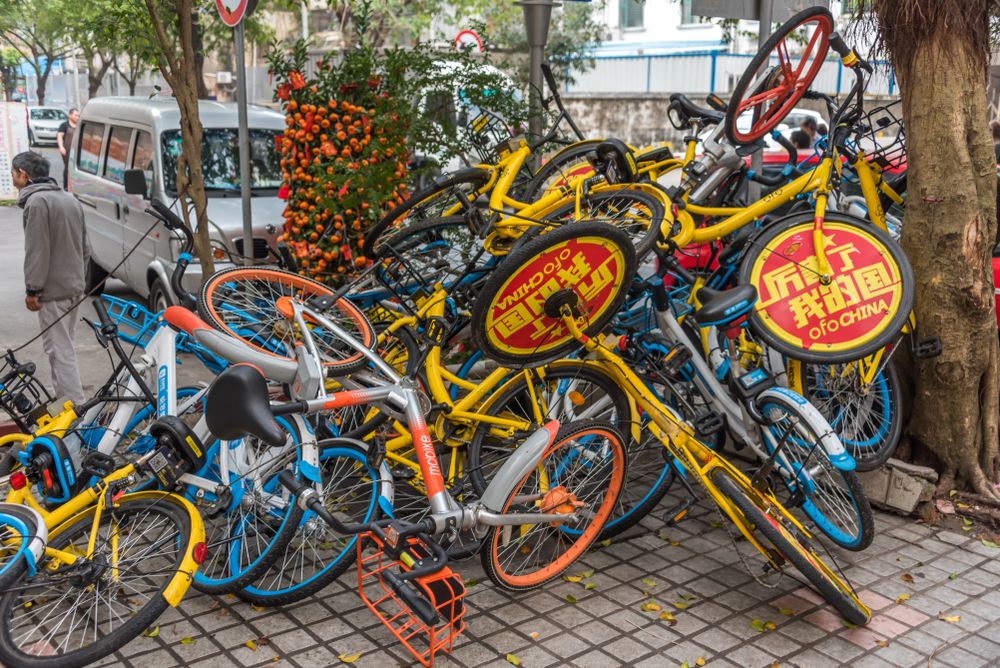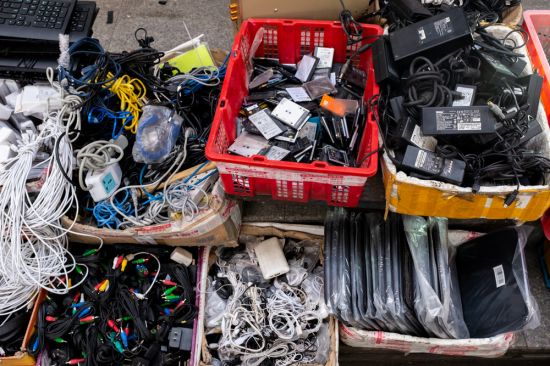Given that China, as the most populous developing country, consumes nearly half of worldwide steel and cement production, and is the largest carbon emitter and solid waste generator, accelerating its transition to a circular economy is crucial to driving the global transition to sustainable development, argues Han Shi, an industrial chain and circular economy specialist. Drawing on China’s own experience and lessons from other nations, Beijing could demonstrate that the circular economy is less of a natural resource and environmental protection strategy and more a future-proof, carbon-neutral economic development model.
Abandoned share bikes in Zhuhai: The sharing and collaborative economy is an accepted part of the circular model (Credit: beersonic / Shutterstock.com)
A circular economy is something of an ideal of sustainable development. In the prevailing “take-make-use-dispose” linear consumption model, raw materials are extracted and transformed into products, which are purchased by consumers who eventually toss them out, creating waste. In a circular world, everything from armchairs to zithers would be designed and created to be shared, rented, reused, recycled and repurposed for as long as possible to limit waste, pollution and greenhouse gas emissions.
In its urgent yet painfully slow attempt to move from the linear towards a circular economy, China has blazed the sustainability trail, together with Germany and Japan. As early as 1999, the innovative concept was highlighted in the local sustainability agenda of the municipality of Shanghai, China’s economic powerhouse, and the first national government-wide action plan for a circular economy was adopted in 2005. Circular economy initiatives have been incorporated into China’s paramount Five-Year Plans for National Economic and Social Development since 2006, while the country’s – and the world’s – first law using the term came into force in 2009.
Yet, China’s two-decade quest to create a circular economy has achieved much less than expected, and its prominence has receded in the last four Five-Year Plans. Take industrial solid waste, for example. The gross volume of industrial solid waste grew from 2.41 billion tonnes in 2010 to 4.41 billion tonnes in 2019, with an average annual growth rate of 7 percent. Meanwhile, the recycling rate declined from 67.2 to 52.6 percent during the same period. In 2019, China used up 51.3 percent of world steel and 44.3 percent of cement, emitted 27 percent of global carbon emissions, and produced 16.3 percent of global gross domestic product. The scale of Chinese resource consumption is unprecedented. Billionaire humanitarian Bill Gates made the point in an eye-catching blog post in 2014 noting that China used more cement between 2011 and 2013 than the US did in the entire 20th century.
To decipher the main reasons for these outcomes, we must first examine the origins and evolution of the circular economy in China. During its local sustainability planning process in 1998, Shanghai learned from their German and Japanese counterparts about circular approaches to deal with the looming municipal waste crisis. In 2003, a task force under the China Council for International Cooperation on Environment and Development (CCICED), an international advisory group with Canada as lead partner, proposed a circular economy strategy in tandem with cleaner production to the State Environmental Protection Administration, the predecessor of the Ministry of Ecology and Environment (MEE), as a more conciliatory approach to addressing the nation’s worsening industrial pollution.
When the National Development and Reform Commission (NDRC), China’s main economic planning agency, took over the leadership of advancing the circular economy in 2004, its Conservation and Comprehensive Utilization of Resources Department assumed the day-to-day management of this mandate. This arrangement naturally meant a strong focus on the recycling of industrial wastes which the unit had been advocating since the mid-1980s.
The slow uptake of the circular economy in China can be attributed to a number of reasons. First, when the NDRC took over the leadership role, this framed the concept mainly as a crucial solution to the nation’s natural resource supply security. When the global financial crisis of 2008-09 sent the prices of global commodities plummeting, the primary motivation for the circular economy had lost its urgency. The aim of designing and manufacturing out waste from all products and services was not readily accepted as the basis for a new economic development model. Rather, it was regarded more as a complex way of utilizing resources, a means to improving the recycling of industrial and municipal solid waste.
Related to this was the problem of “siloization” in the bureaucracy, a situation not unique to China. Even related government departments tended to work in silos, leading to fragmented approaches to implementing the circular economy. For instance, research and development support was conducted as a separate program targeting recycling technologies instead of being integrated across all R&D initiatives.
Third, China’s top-down approach has not been matched with bottom-up efforts to mobilize business and consumers. For industry, the circular economy has been treated primarily as an add-on activity aimed at greater recycling of industrial waste. As a result, only a limited segment of the industrial sector, i.e. resource recovery and waste management, has actively pursued this goal. Only recently have a few e-commerce conglomerates started dealing with the gigantic amount of packaging waste associated with their businesses.
Globally, the sharing and collaborative economy has been increasingly accepted as part of the circular economy. China’s bicycle-sharing businesses, however, missed out on the opportunity to incorporate circular-economy principles. The rapid fall of Beijing-based ofo and other bike-sharing companies left many “bike graveyards” across the country. The Yangon-based not-for-profit Lesswalk bought up abandoned share bikes from China and distributed them for free to needy students in Myanmar. This clearly demonstrated the power of ingenuity and entrepreneurship in implementing the circular economy, unfortunately through an initiative outside China.
Fourth, China has relied mainly on regulatory instruments to implement circular economy action. While related regulations such as extended producer responsibility have proven difficult to enforce, the lack of economic incentives has become a bigger roadblock. Market-based instruments targeting resource efficiency remain scant and perverse public subsidies for fossil fuels and water resources have exacerbated the decline of resource productivity. For instance, cut-throat competition has driven the tariff for municipal solid waste landfilling down to 40-80 renminbi per tonne. China formally imposed the national environmental protection tax in 2018 and revenues subsequently collected from industrial solid waste totaled only 240 million renminbi, merely 1.6 percent of total environmental tax revenue.
Fifth, the legal underpinnings for a circular economy are relatively toothless and warrant urgent revision. The legislation was more policy inspiration rather than mandatory legal requirement. Indeed, the original Circular Economy Law was renamed the Circular Economy Promotion Law just before its third and final reading at the National People’s Congress in 2008. This was an acknowledgement of the soft nature of the law.
Given that China, as the most populous developing country, consumes nearly half of worldwide steel and cement production, and is the largest carbon emitter and solid waste generator, accelerating its transition to a circular economy is crucial to the global transition to sustainable development. Drawing on China’s experience so far and lessons drawn from other countries, the following changes to Beijing’s strategy for pursuing a circular economy could prove vital to jump-start its efforts:
First, main quantitative benchmarks for national and regional development should be established on the basis of proven indicators. Such targets may include resource productivity, minimum circularity, and maximum solid waste for final disposal. To harness effectively the power of performance assessment, related statistics at different levels of government should be monitored and analyzed. Data availability and accuracy will be essential to the legitimacy and public acceptance of reporting and evaluations.
Second, the circular economy law should be amended and given teeth. Under a tougher framework, more timely and specialized regulations can be formulated and implemented. On September 15, 2021, the NDRC launched a month-long campaign to solicit suggestions from the public on how to amend the Circular Economy Promotion Law. Changes could cover the name of the legislation, the definition of circular economy, and the obligations and incentives for implementing it. This clearly sent a positive signal that the government aims to strengthen the statute.
Third, building on the momentum of developing the national Emission Trading Scheme (ETS) for greenhouse gas emissions, more efforts should be made to provide the economic incentive to drive the transition to a circular economy. Such measures could include municipal waste discharge schemes, a solid waste landfill tax, and enforcement of the extended producer responsibility (EPR) – which makes the manufacturer responsible for the entire life cycle of the product including recycling and final disposal – for an expanding range of consumer goods. (The UK introduced its Landfill Tax in October 1996 at a rate of £7 per ton to encourage waste producers and the waste management industry to switch to more sustainable alternatives for disposal. The rate has steadily been increased, rising to £96.70 per ton in 2021.)
Fourth, measures are needed to sensitize and motivate businesses and consumers to embrace and put into practice the circular economy. For companies, regulations to mandate eco-design of environmentally polluting products and EPRs should be put forward. More vigorous activities should be sought to promote innovative business models such as product-as-a-service (PaaS) in which a product is combined with service contracts to repair or replace.
Innovative business models based on a closer relationship with customers, mass customization, the sharing and collaborative economy, and powered by the Fourth Industrial Revolution technologies such as the Internet of Things, Big Data, Blockchain, artificial intelligence, and additive manufacturing, will not only accelerate circularity but also the dematerialization of the Chinese economy. This will make China less vulnerable to resource supply security risk.
Finally, government departments should collaborate better in advancing the circular economy across the board. For instance, there could be better cooperation and coordination between the Zero-Waste City Pilot Program led by the MEE, the Garbage Sorting program championed by the Ministry of Housing and Urban-Rural Development (MOHURD), and the Urban Mining Program to recover metallic resources from e-waste led by the NDRC. The Ministry of Industry and Information Technology (MIIT) should highlight the circular economy in its green manufacturing initiatives and promote a strong and coherent product policy framework that will make sustainable products, services and business models the norm.
Based on the lessons learned from its two decades of experience and the efforts of other countries, there is reason to be more optimistic that China is capable of rebooting its circular economy program. Heightened geopolitical tensions, rising commodity prices in the post Covid-19 economic recovery, and the growing adoption of new technologies could lead to a change in attitude towards the circular economy – from a primarily a natural resource and environmental protection strategy to a valid future-proof, carbon-neutral economic development model.
With its aging demographics, China should be more open to the shift from an extensive economic expansion growth model to a stock-optimization one, from a quantity-driven to a quality-focused approach. Chinese should be more receptive to a circular, low-carbon development paradigm which builds on higher quality, longer lifespan man-made stocks. The key test will be how to shift from the incremental up-front capital investment associated with the latter economic development model and make the policy changes and investments necessary to jump-start China’s transition to a circular economy.
Further reading:
Check out here for more research and analysis from Asian perspectives.

